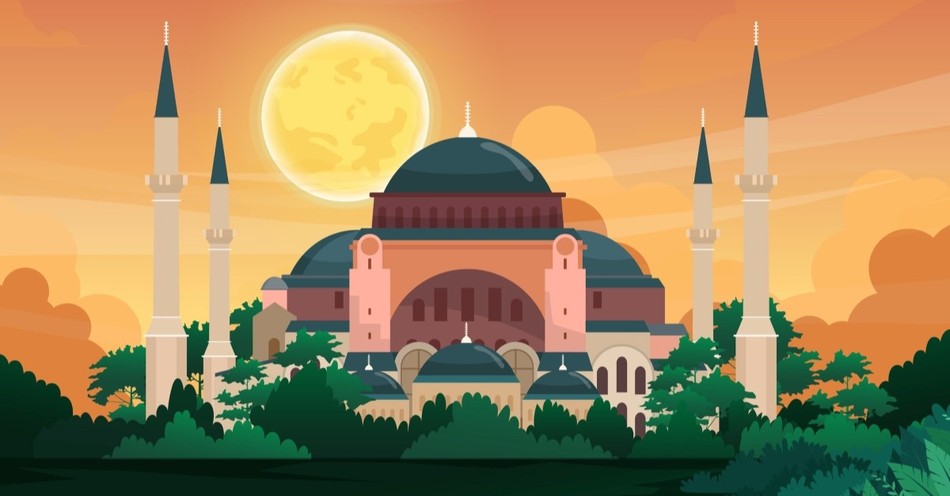While political and religious divisions are common today, the problem is not new. Christians have struggled to get along with each other for a long time.
The story of how Jesus’ disciples and apostles spread the early church’s beliefs throughout the middle east took dramatic turns as the ancient world became the medieval world.
In the church’s formative years, there were five bishops or patriarchs. The patriarchs oversaw the church operation in Alexandria, Jerusalem, Antioch, Constantinople, and Rome. The patriarch in Rome, now known as the pope, ruled at the top of the church hierarchy.
The Roman Empire and the Roman Catholic Church spread their influences, eventually reaching from the upper corners of Ireland to Egypt. However, the Roman government and the Catholic church split into two branches. The Western Roman Empire centered in Rome, following the teachings of the Roman Catholic Church. The Eastern Roman Empire, renamed the Byzantine Empire, centered in Constantinople, with an Eastern Orthodox Church following.
What Connects the Byzantine Empire to the Eastern Roman Empire?
The territory of the Byzantine Empire was originally part of the Roman Empire. It was all one centrally governed territory in the early Christian church days of 27-286 CE. Rome evolved as a monarchy, then a republic, then an empire. In 286 CE, Emperor Diocletian split the empire along geographic and cultural lines, with Latin-speaking Christians in the Western Roman Empire and Greek-speaking Christians in the Eastern Roman Empire. The two territories became separately governed entities from that time into modern history.
After the governments in Rome and the Eastern Roman Empire—renamed the Byzantine Empire after the capital city’s original Greek name of Byzantium—parted ways, Constantinople became the new name of the Byzantine Empire’s capital. Named after its founder, Emperor Constantine was the most powerful city in the world at that time. The city’s natural harbor was a major seaport between Europe and Asia, providing access to goods from the fertile lands of Western European and the exotic trade goods of the Middle East and the Far East.
Other large cities in the Byzantine Empire included Alexandria and Antioch, with populations of up to 50,000 people. Together with Jerusalem, the Byzantine Empire had a population of several hundred thousand people in the third century CE.
The Byzantine Empire preserved the Greek tradition of intellectual discourse in philosophy and science. There was an upper echelon of citizens in the Byzantine Empire, a humble underclass, and then enslaved people.
What Separates the Byzantine Empire from the Holy Roman Empire?
Besides language and ethnic differences, a major difference between the Byzantine Empire and the Holy Roman Empire was how Catholic Christianity was practiced in the two regions. Emperor Constantine made Christianity the official state religion of Rome in 313 CE, ending the persecution of Christians. From the start, however, there were major theological differences between the Western and Eastern church branches (later the Roman Catholic Church and the Eastern Orthodox Church). Each faction looked at members of the other branch of the Christian church as heretics, not to be tolerated.
As centuries passed, the patriarch of Constantinople resisted the authority of the bishop in Rome, who led the spiritual practices of the other four bishops of the Roman Catholic Church. The patriarch of Constantinople was second only to the pope in Rome in the church’s ruling hierarchy, according to the Council of Chalcedon of 451 CE. Like many church denominations operating today, the Roman Catholic Church separated into two groups in 1054 CE. The religious division of the Roman Empire, called “The Great Schism,” echoed the political division of the Roman Empire in 330 CE.
The schism began when the patriarch of Constantinople, Michael Cerularius, circulated a treatise in 1053 criticizing several practices of the Roman church:
- venerating icons
- requiring clergy to be unmarried
- using unleavened bread for the Eucharist
In Rome, St. Leo’s edit of the Nicene Creed was the final straw for the eastern church: Leo removed the words “and the Son” from a phrase of the Nicene Creed that read “the Holy Spirit which proceeds from the Father and the Son.” Bishop Cerularius excommunicated all the bishops in Constantinople who followed the Roman church’s doctrine. He closed their churches. Pope Leo retaliated by excommunicating Cerularius. Cerularius then excommunicated St. Leo. The western regions of the church remained true to the original Roman Catholic Church, and the eastern churches became the Eastern Orthodox Church. The rift between the two churches lasted almost a thousand years.
How Did the Byzantine Empire Affect the Catholic Church?
The Eastern Orthodox Church in the Byzantine Empire developed its own traditions and culture. Parish churches maintained a localized power structure with spiritual authority resting on a congregational priest and the region’s bishop. The churches of the Western Roman Empire bowed to the power and authority of the patriarch of Rome, the pope. Across the Roman Empire, the other four church patriarchs—in Antioch, Alexandria, Jerusalem, and Constantinople—believed that Christ alone was the head of the church. This element of Eastern Orthodox theology remains central today.
The eastern and western arms of the original Catholic Church moved from disagreeing over theological issues to becoming enemies, inflamed by the Crusades of the Roman Catholic Church. The Crusades lasted from 1095 to the 1500s, with both sides experiencing massive casualties. Death estimates range from one million to nine million lost lives.
The Crusades and the rise of Islam weakened the Byzantine Empire’s power in Antioch, Alexandria, and Constantinople. During the Fourth Crusade of 1204, Christian soldiers from the West captured Constantinople and removed its influence over Eastern Orthodox Christians. However, Byzantine soldiers recaptured Constantinople in 1261 and restored the Byzantine capital. Then, in the 1400s, Constantinople fell to Muslim rule and became the center of the Ottoman Empire. This change occurred during the chaos of another Crusade—on May 29, 1453, when Constantinople fell to Sultan Mehmed II.
How Long Did the Byzantine Empire Last?
Constantinople became home to a remnant of about 171,000 Christians living “in the shadow” of Muslims in the fifteenth century. The Ottoman Empire included Orthodox Christians, Muslims, and Jews who settled there as time passed, all worshipping God in their own way.
The Ottoman Empire continued to the modern period, fighting in World War I alongside the Central Powers—Germany and Austria. Ineffective political and military action led to the deaths of hundreds of thousands of Ottoman citizens and the Armenian genocide. Following World War I, Islamic rule and the Ottoman Empire dissolved. Its territory became the modern Republic of Turkey in 1923.
The Eastern Orthodox Church continues into contemporary history, with parishes worldwide. The Church of God, Saint Hagia Sophia, or “Holy Wisdom,” in Constantinople still is the center of Eastern Orthodox Christianity. The old, walled city of Constantinople remains in Istanbul, Turkey.
The Eastern Orthodox Church and the Roman Catholic Church reconciled their differences in the Second Vatican Council of 1962, when the pope recognized the sacraments of the Eastern Orthodox Church, 911 years after the Great Schism. In 1965, Pope Paul VI and the patriarch of Constantinople revoked their excommunications.
The ” Byzantine” is often used to mean “complicated” and “difficult to follow.” The rich and varied history of the Byzantine Empire proves worthy of the moniker. However, its history changed Christian civilization in crucial ways, making it an important piece of history to study.
Photo Credit: © Getty Images/Jcomp

This article is part of our Christian Terms catalog, exploring words and phrases of Christian theology and history. Here are some of our most popular articles covering Christian terms to help your journey of knowledge and faith:
The Full Armor of God
The Meaning of "Selah"
What Is Grace? Bible Definition and Christian Quotes
What is Discernment? Bible Meaning and Importance
What Is Prophecy? Bible Meaning and Examples


.jpg)
